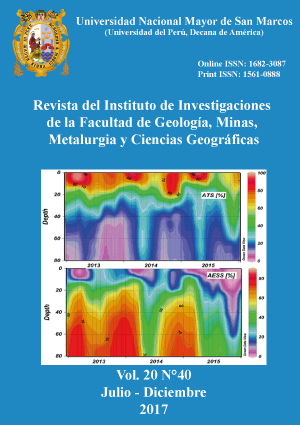Impact on cholinesterase levels in tomato farmers (Solanum lycopersicum L) in the locality of San Luis, Chimborazo due to the use of organophosphorus insecticides and carbamates
DOI:
https://doi.org/10.15381/iigeo.v20i40.14400Keywords:
Levels, cholinesterase, insecticides, carbamates, organophosphatesAbstract
This research aimed to determine the application conditions that affect cholinesterase levels, and generate a neurotoxic risk by the use of carbamates and organophosphates to tomato farmers (Solanum lycopersicum L.) in the town of San Luis, Chimborazo - Ecuador. The technique used was spectrophotometry. Cholinesterase examination was carried out in patients exposed to organophosphate and carbamate insecticides. The method used was the kinetic spectrophotometric (405 nm at 37 °C). Through factor analysis, the Kruskal Wallis and correlations were determined, the variables that affect cholinesterase levels. For the neurotoxicological analysis, it was applied, the questionnaire Psychologisch Neurologischeò Fragebogen (PNF) to each of the farmers, which allowed us to determine the presence of, clinical disorders, behavioral and neurological, in workers exposed to organophosphate and carbamate pesticides. Concluding that the variables that affect cholinesterase levels are: humidity, temperature in the greenhouse, time when grown tomato, state of application equipment, while remaining in the greenhouse, frequency of application of insecticides, read the label, time of insecticides application, and the most affected areas were psycho neurovegetative instability (PN), irritability (E), deficiency of concentration and memory (K) and asthenia (a).Downloads
Published
Issue
Section
License
Copyright (c) 2017 Víctor Alberto Lindao Córdova, Jorge Leonardo Jave Nakayo, Mónica Guadalupe Retuerto Figueroa, Norma Soledad Erazo Sandoval, Magdy Mileni Echeverría Guadalupe

This work is licensed under a Creative Commons Attribution-NonCommercial-ShareAlike 4.0 International License.
AUTHORS RETAIN THEIR RIGHTS:
a. Authors retain their trade mark rights and patent, and also on any process or procedure described in the article.
b. Authors retain their right to share, copy, distribute, perform and publicly communicate their article (eg, to place their article in an institutional repository or publish it in a book), with an acknowledgment of its initial publication in the Rev. Inst. investig. Fac. minas metal cienc. geogr.
c. Authors retain theirs right to make a subsequent publication of their work, to use the article or any part thereof (eg a compilation of his papers, lecture notes, thesis, or a book), always indicating the source of publication (the originator of the work, journal, volume, number and date).






